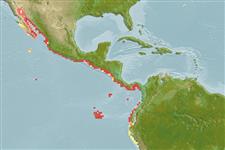Environment: milieu / climate zone / depth range / distribution range
Ecología
marino asociado a arrecife; rango de profundidad 10 - 60 m (Ref. 91172). Tropical; 33°N - 12°S, 115°W - 78°W (Ref. 55)
Eastern Pacific: Mexico to Peru.
Length at first maturity / Tamaño / Peso / Age
Maturity: Lm 26.4, range 17 - 18 cm
Max length : 105 cm TL macho / no sexado; (Ref. 106806); peso máximo publicado: 1.3 kg (Ref. 40637)
Espinas dorsales (total): 10; Radios blandos dorsales (total): 12-13; Espinas anales 3; Radios blandos anales: 8. Preopercular notch and knob weak. Scale rows on back rising obliquely above the lateral line. Pale crimson on side, often with silvery sheen of horizontal rows of bluish spots; belly golden yellow. Head with bluish spots and irregular broken lines, especially across cheek. A large blackish blotch on the upper back below the posterior of the dorsal spines.
Adults are found over hard bottoms in inshore reef areas. Generally solitary or in small groups but may occasionally form big schools (Ref. 9313). Juveniles inhabit estuaries and mouths of rivers (Ref. 9313). Carnivorous, feed on invertebrates and fish (Ref. 9313). Marketed fresh or frozen (Ref. 9313).
Allen, G.R., 1985. FAO Species Catalogue. Vol. 6. Snappers of the world. An annotated and illustrated catalogue of lutjanid species known to date. FAO Fish. Synop. 125(6):208 p. Rome: FAO. (Ref. 55)
IUCN Red List Status (Ref. 130435)
Threat to humans
Harmless
Human uses
Pesquerías: comercial; pesca deportiva: si
Más información
ReferenciasAcuiculturaPerfil de acuiculturaRazasGenéticaElectrophoresesheritabilidadEnfermedadesProcesamientoNutrientsMass conversion
ColaboradoresImágenesStamps, Coins Misc.SonidosCiguateraVelocidadTipo de nataciónSuperficie branquialOtolitosCerebrosVisión
Herramientas
Special reports
Download XML
Fuentes de Internet
Estimates based on models
Preferred temperature (Ref.
123201): 22.3 - 29.1, mean 26.2 °C (based on 214 cells).
Phylogenetic diversity index (Ref.
82804): PD
50 = 0.5000 [Uniqueness, from 0.5 = low to 2.0 = high].
Bayesian length-weight: a=0.01349 (0.00844 - 0.02157), b=2.91 (2.78 - 3.04), in cm total length, based on LWR estimates for this species & Genus-body shape (Ref.
93245).
Nivel trófico (Ref.
69278): 4.0 ±0.2 se; based on diet studies.
Resiliencia (Ref.
120179): Medio, población duplicada en un tiempo mínimo de 1.4-4.4 años (K = 0.19; Fec = 66,400).
Prior r = 0.57, 95% CL = 0.37 - 0.85, Based on 1 stock assessment.
Fishing Vulnerability (Ref.
59153): Low to moderate vulnerability (35 of 100).
Nutrients (Ref.
124155): Calcium = 28.4 [17.6, 41.8] mg/100g; Iron = 0.327 [0.204, 0.502] mg/100g; Protein = 18.8 [17.3, 20.2] %; Omega3 = 0.127 [0.086, 0.183] g/100g; Selenium = 71.2 [46.4, 111.1] μg/100g; VitaminA = 88 [17, 326] μg/100g; Zinc = 0.362 [0.282, 0.513] mg/100g (wet weight);
